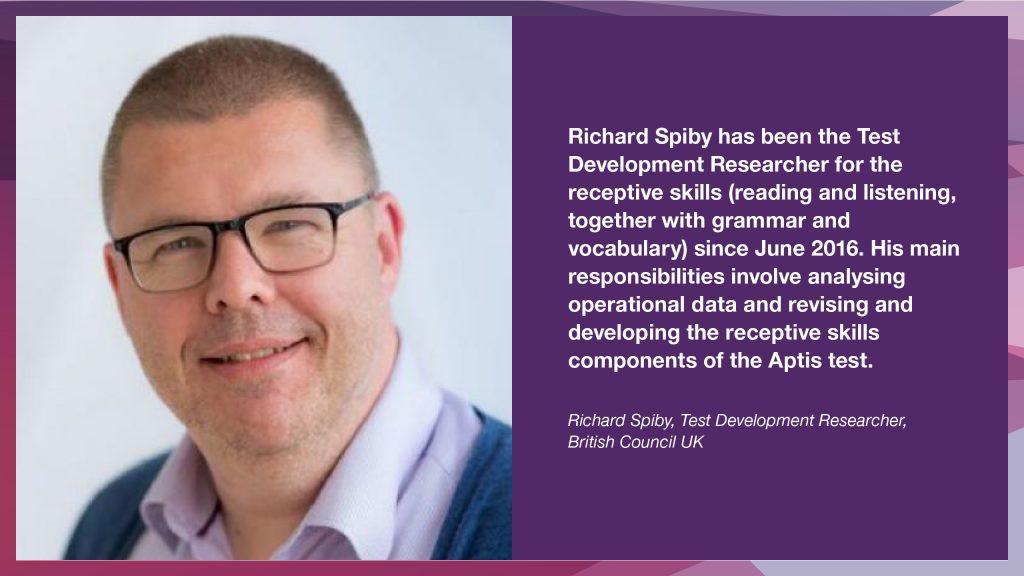In this interview, Adrian Raper (AR) talks to Richard Spiby (RS) from the British Council on the CEFR and the importance of teaching to the test construct.
AR: Richard, we know that more and more tests, like Aptis for example, are CEFR-aligned. That’s good for standardising results for the test takers themselves. But I’m wondering what sort of impact this can have on teachers?
RS: Well, let’s start by looking at the test construct. The construct is what the test is there for, what it is actually testing. And if the test is aligned with the CEFR, then it is also aligned with particular can-do statements. And this means that when teachers are preparing students for a test, there are going to be no surprises. This is why educators are obsessed by the test construct. What good testers want to see is that the test encourages teaching to the construct.
AR: Is that the same as teaching to the test?
RS: It’s different from teaching to the test. When you teach to the test, materials look exactly like the test. They are often done in test conditions. And basically students do a lot of mock tests. And you know, these things are useful — they give students a good idea of what to expect — but it’s quite indirect in terms of teaching the skills students need.
Tony Green did some research on students taking IELTS courses. He compared them to students who did general English or academic English courses. He found that the people who were doing the more general courses rather than the test prep courses actually did better on the test.
That’s because they were focusing on the skills that they needed to perform well in the test rather than on the test itself. So if we get obsessed by test prep, that’s actually to the detriment of our students’ learning. And test prep, which is actually very necessary, should actually just be the final stages before they take an exam like IELTS.
AR: How does the CEFR help with teaching to the construct?
RS: Teachers need to be thinking about the construct of the test: what are the abilities that the test is testing? And then they need to teach to those abilities. This is where CEFR levels and can-do statements come in. If our test is aligned to the CEFR, that means that we can link it to can-do statements which means that can-do statements can be linked to syllabuses and can be linked to objectives in the classroom. So those can-do statement become our objectives.
AR: What if a teacher knows that the exit exam is CEFR-aligned and they are given a syllabus from the ministry. How are they tied together?
RS: Well, one thing that people should be doing if they are working towards CEFR-aligned exams is mapping their syllabus to the CEFR. Ideally you would have a committee of teachers who would go through all the materials and it could be a one-year project.
You map all of your materials, all of your syllabus objectives onto the CEFR to see which levels they come in at. And we would hope that they would all come in at a fairly consistent level, that we would see some kind of progression and that there would be a match between the syllabus objectives and the test construct.
AR: Would you make the test construct explicit to students?
RS: Why not look at the test and give them can-do statements for self assessment? You can use the three-checkbox system where students can say “Yes, I can do this very well”, or “I can do it a little bit, but I need more practice”, or “No, I don’t know anything about this. I’ve got a lot more work to do.” By doing this, throughout the course, throughout the year, they can see how far they are getting in terms of those objectives.
So for example, with the Aptis test, we look at the washback we want from our test. That’s the impact we have on teaching and learning. Let’s say a test taker gets an A2 score. If they want to take Aptis again and get to the B1 level, then it’s the B1 descriptors that they need to be focusing on. And if you are a learner, that should be defining your course of learning over the following few months.
It gets students thinking about their learning rather than focusing on mock tests. That’s really important. It makes them feel more connected with the whole learning system. And when they are doing the test, or preparing for the test, and it uses similar language to the CEFR to describe what is expected, then suddenly everything falls into place and it makes sense to them.
And that’s the great beauty of the CEFR — it’s a framework to hang everything on. It brings it all together.
You can contact Richard at Richard.Spiby@britishcouncil.org

